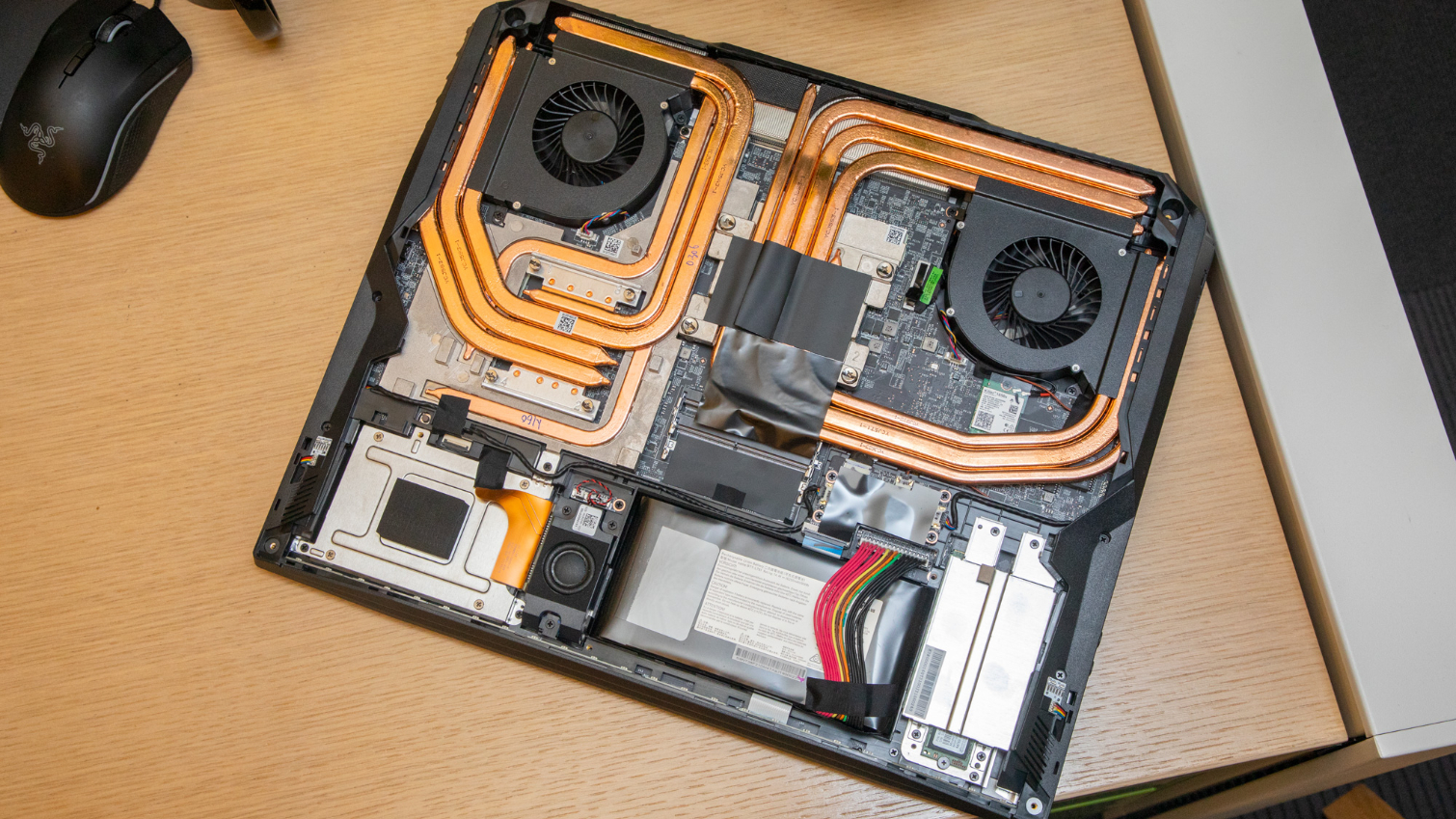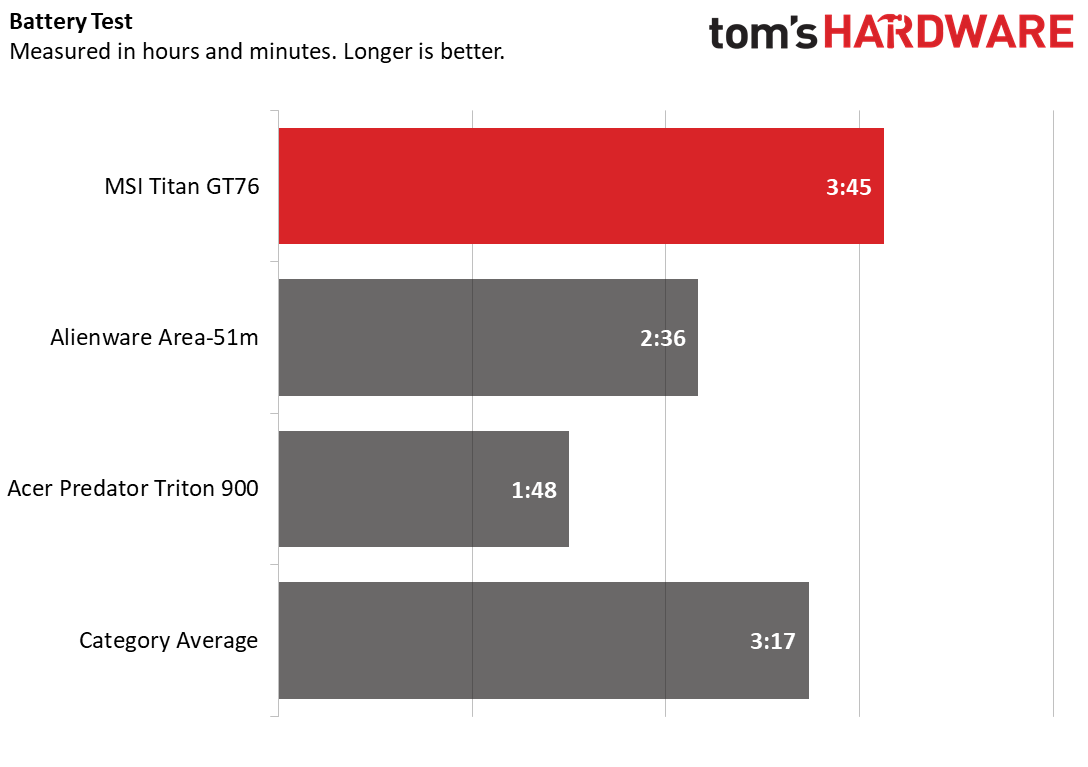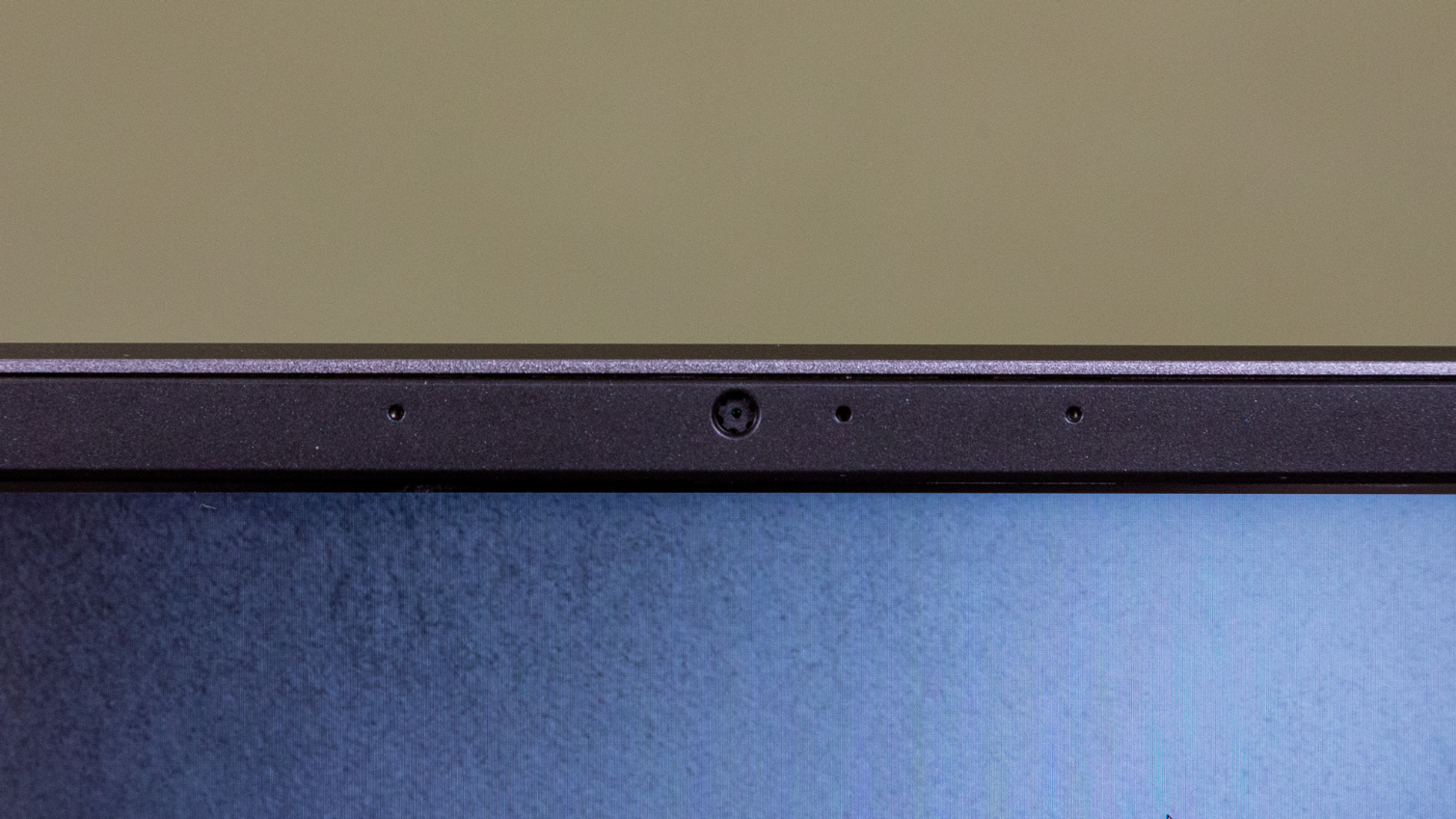Tom's Hardware Verdict
The MSI GT76 Titan gaming laptop has powerful performance with a desktop class processor, and a comfortable keyboard, but it’s also very expensive.
Pros
- +
Bright 4K display
- +
Comfortable keyboard
- +
Easy upgrading
Cons
- -
Very pricey
- -
Poor webcam
- -
Doesn’t hit 5GHz all-core claim
Why you can trust Tom's Hardware
There are some laptops in the world that just seem like someone took a desktop and put a screen on it. That’s the category that the MSI GT76 Titan ($3,599 / £3,499 to start, $4,599 / £4,499 as tested) falls into. It’s a chonky desktop replacement laptop, with 11 heat pipes cooling a desktop Intel Core i9-9900K and Nvidia GeForce RTX 2080. It has a bright, 17-inch screen and boppin’ speakers, but you’ll pay a lot for the system, and the CPU can be tough to keep cool.
Design
The Titan is a behemoth of a notebook, a tank-like desktop replacement that looks powerful -- even intimidating -- whether it's fired up and flashing, or switched off and closed. MSI had ditched its usual black-and-red design for a dark gray approach. The dark-gray aluminum lid has two diagonal lines on it, but is otherwise sparse aside from a silver version of the MSI logo. In fact, the lid looks much like Alienware’s designs up until 2018.




Behind the lid is an extended rear end with massive vents for cooling. The covering for that section is plastic, not aluminum.
When you lift the lid, the 17.3-inch 4K display is surrounded by narrow bezels. The metal deck has soft touch paint on it, which is comfortable for typing. Out of the box, the RGB keyboard is all rainbow.
Below the wrist rest, there’s an RGB light bar, which bounces light off of your desk, and two smaller light bars sit on either side of the notebook. Both the keyboard backlight and light bars can be adjusted in the included SteelSeries Engine 3 software.
I rarely talk about the bottom of the laptop, but this Titan has a mesh pattern that has plenty of little holes that let you see inside. It effectively looks like a giant dust filter from a desktop, but on the underside of a notebook.


There's plenty of room for ports on the Titan, and MSI takes advantage of the space. On the left side sits the power jack (which uses a reversible port that connects to two 230-watt power bricks), an Ethernet port, Thunderbolt 3, two USB 3.2 Gen 2 Type-A ports and headphone and microphone jacks. On the right side, there’s a microSD card slot, another pair of USB 3.2 Gen 2 Type-A ports, a USB 3.2 Gen 2 Type-C port and, for video out, mini DisplayPort and HDMI.
Get Tom's Hardware's best news and in-depth reviews, straight to your inbox.
At 9.2 pounds / 4.2 kg, the Titan is one of the heavier laptops we’ve had in the lab recently, and at 15.6 x 13 x 1.7 inches (397 x 330 x 42 mm), it’s also quite large. The Acer Predator Triton 900 is slightly lighter at 9 pounds flat and measures 16.9 x 11.9 x 0.9 inches. Alienware’s Area-51m, which also houses a desktop CPU, is 8.5 pounds and 16.1 x 15.9 x 1.7 inches. Also, consider that the dual power bricks are (yes, there are two), add another 5.2 pounds to the Titan. So you’ll be carrying 14.4 pounds (6.5 kg) in total when you carry the GT76 Titan around.
Specifications
| Display | 17.3-inch, 4K (3840x2160), 60Hz, IPS-level |
| CPU | Intel Core i9-9900K (desktop CPU) |
| Graphics | Nvidia GeForce RTX 2080 (8GB GDDR6) |
| Memory | 64GB DDR4-2666 |
| SSD | 2x 512GB SSD in RAID0 |
| HDD | 1TB, 7,200-rpm |
| Networking | Ethernet port, Killer Wi-Fi 7 AX1650x, Bluetooth 5 |
| Video Ports | HDMI, Mini DisplayPort |
| USB Ports | 4x USB 3.2 Gen 2 Type-A, 1x USB 3.2 Gen 2 Type-C, 1x Thunderbolt 3 |
| Audio | 2x 2W speakers, 1x 3W woofer |
| Camera | 720p |
| Battery | 90 WHr |
| Power Adapter | 2x 230W |
| Operating System | Windows 10 Pro |
| Dimensions (WxDxH) | 15.6 x 13 x 1.7 inches / 397 x 330 x 42 mm |
| Weight | 9.2 pounds / 4.2 kg |
| Price (as configured) | $4,599 / £4,499 |
Gaming, Graphics and VR
MSI equipped the Titan with an Nvidia GeForce RTX 2080 with 8GB of GDDR6 memory, which is capable of playing most games at their highest settings, even some of them at 4K. When I played the Battlefield V mission “The Last Tiger” in 1080p on ultra settings including ultra ray tracing, it ran between 32 and 43 fps.




On Rise of the Tomb Raider (1080p, very high), the Titan played the game at 96 frames per second, well above the premium gaming laptop average (68 fps) and faster than the Predator (93 fps), but the Alienware ran at 103 fps. At 4K, the Titan ducked down to 28 fps, so you’d want to drop some settings down to get it to a playable frame rate.
On the Hitman benchmark (1080p, ultra), the Titan reached 113 fps, beating the average (105 fps) but falling behind the Triton (132 fps) and the Area-51m at a whopping 143 fps. At 4K it hit 70 fps.
When we turned to Grand Theft Auto V (1080p, very high), the Titan tied the Alienware at 105 fps, both of which surpassed the average (79 fps), but were a single frame behind the Predator. At 4K the benchmark ran at 34 fps.
The Titan sailed passed the 92-fps average on the Middle-earth: Shadow of War benchmark at 110 fps, though both the Alienware and Predator were faster.
To stress test the Titan, I ran the Metro Exodus benchmark 15 times on RTX settings, simulating approximately half and hour of gaming. During the test, the Titan ran the game at an average of 57.9 frames per second. The first run went by at 59.9 fps, but then it slowly dropped to 58 and sometimes lower, ending at 58.5 fps.
During the stress test, the CPU ran at an average clock speed of 4.5 GHz, not quite matching the 5 GHz max boost clock the Intel Core i9-9900K allows or that MSI promises (and all-core, at that). The average CPU temperature was 73.8 degrees Celsius (164.8 degrees Fahrenheit).
The GPU’s average clock speed was 1.5 GHz and its average temperature was 82.3 degrees Celsius (180.1 degrees Fahrenheit).
Productivity Performance
The GT76 packs a desktop-class Intel Core i9-9900K, providing a ton of power in a laptop form factor--albeit a big and heavy one.
On Geekbench 4.1, it earned a score of 31,267, just behind the Alienware Area-51m with the same processor. The premium gaming average is 23,228 and the Predator notched a score of 24,749.
It took the Titan 4 seconds to copy 4.97GB of files, a rate of 1,272.3 MBps. That’s the same as the Alienware, and high above the 848.2 MBps of the Predator and the 769.7 MBps average.
The Titan took 5 minutes and 51 seconds to complete our Handbrake test, in which the laptop converts a 4K video to 1080p. The average is 9:36. The Alienware took 6 minutes and the Predator was behind at 9:55.
Display
The 17.3-inch, 4K screen on the Titan gets brighter than many other gaming notebooks. The fire from a rocket launching at the beginning of the 4K open source film Tears of Steel was nearly a blinding white. And even darker content, like a scene in which a sniper looks off a building during a stormy night, were bright and clear on the screen. When I played Battlefield V, fires on exploding tanks were a bright orange.
MSI’s screen covers 157 percent of the sRGB color gamut, beating the premium laptop category average (147 percent) and the Alienware but falling a tad behind the Predator.
The Titan's screen measured an average of 376 nits of brightness, surpassing the average of 294, as well as the Predator and the Alienware.
MSI refers to its display as IPS-level, but the term “IPS” is typically tied to LG panels. This screen is from AUO, so IPS-level is its way of referring to its performance relative to those panels.
Keyboard and Touchpad
The Steelseries keyboards on MSI laptops continue to be some of my favorites, and the one on the Titan is no exception. The keys are bouncy and clicky, making them comfortable with a deep 1.7 mm of travel with 70 grams of actuation force. On the 10fastfingers.com typing test, I hit 109 words per minute with my usual 2% error rate.
This is, however a slight step back from previous Titans, like the GT75, which had mechanical keyboards.
The 4.2 x 2.3-inch touchpad uses Windows 10 Precision drivers, which all Windows laptops should. Every gesture worked on the first try and the touchpad is smooth and comfortable to navigate with.
Audio
A laptop this big ought to be loud, and the Titan sure is. When I took the laptop into a medium-sized office and blasted Queen’s “Another One Bites the Dust,” the iconic bassline boomed and people outside the room started looking in through the glass walls in surprise. The vocals were a little strained, though.
I was able to turn the bass up even more with the Nahimic audio software, but it didn’t do much for fixing the vocals.
When I played Battlefield V, the missiles shooting from my tank landed with explosive thuds, though some comms weren’t as clear as on other systems.
Upgradeability
The Titan is easy to open and has plenty of serviceable parts. There are six screws on the underside of the laptop (one of which is under a factory seal sticker, which will reveal to the company if you opened it). When you remove the bottom of the chassis, your eyes will likely be drawn to the 11 heat pipes -- there's a lot of cooling here for a laptop. The battery is user replaceable, as are the HDD and the SSDs.
The SSDs are under a small heat shield with a pair of thermal pads attached. Ours had SSDs in the bottom and one of the two spots covered by a thermal pad, and there is room for one more drive. There are two RAM slots, and ours were both empty. MSI told me the 32GB in our review system were in slots on the other side of the board. If you’re willing to take the entire motherboard out, you could get up to 128GB of RAM in the Titan.
Battery Life
It’s rare that I’m surprised at how long a gaming laptop lasts on a charge, but the Titan delivers on that front. It lasted 3 hours and 45 minutes on our test, which constantly browses the web, streams video and runs OpenGL benchmarks at 150 nits of brightness. And that’s despite its desktop CPU. The premium gaming average is 3:17, and both the Alienware and Predator fell below that.
Heat


Under stress, the GT76 Titan can get quite steamy. We measured skin temperatures during our stress test running Metro Exodus for roughly half an hour. During that time, the center of the keyboard between the G and H keys hit 39.6 degrees Celsius (103.3 degrees Fahrenheit), the touchpad hit 28.9 degrees Celsius (84 degrees Fahrenheit) and the bottom of the laptop climbed to 57.9 degrees Celsius (136.2 degrees Fahrenheit).
Webcam
The 720p camera on the Titan is a disappointment. A photo I took sitting at my desk was blurry, with my face bordering on being an impressionist painting. My hair all blurred together and my skin had more of a red shade than it does in real life. I suggest using an external webcam.
Software and Warranty
MSI’s suite of preinstalled software has become familiar at this point. Dragon Center lets you see CPU, GPU, memory and disk performance and change performance profiles. True Color lets you change the color temperature of the display based on your use case. MSI Help Desk is good in theory, but its warranty checker and contact support option just link you to the company’s web site.
But MSI also adds a lot of junk, including Norton Studio and Evernote. The rest of the bloat, like two different versions of Words with Friends, Fitbit Coach and Spotify come in every build of Windows 10.
MSI sells the GT76 Titan with a 1 year warranty.
Configurations
Our review unit of the GT76 Titan was a maxxed out machine with a $4,599.00 (£4,499) price tag. That nets you a 17.3-inch, 4K display, an Intel Core i9-9900K desktop processor, Nvidia GeForce RTX 2080 with 8GB of GDDR6 memory, 64GB of DDR-2666MHz, a 1 TB, 7,200-RPM HDD and two 512GB PCIe NVMe SSDs in RAID0.
The cheaper model, if you can really call it that, is $3,599.00 (£3,499) with a Core i7-9700K, an RTX 2070 with 8GB of GDDR6 and 32GB of RAM, with the same storage and display.
In theory, you could build a comparable desktop for far less, around the $2,000 mark. But that leaves out Windows, a keyboard, mouse and a display. It also means a less portable form factor, which you’re clearly paying a premium for here -- and with all gaming laptops.
Bottom Line
The MSI GT76 is a massive gaming laptop with desktop-class power thanks to an RTX 2080 and full-desktop-class Intel Core i9-9900K CPU paired with loud speakers and a bright 4K display. But it’s also very expensive, starting at $3,599 and $4,599 as tested.
If you’re looking for something slimmer, Acer’s Predator Triton 900 is cheaper and may do the trick. But you’ll have a laptop CPU and half the RAM of the maxxed out Titan.
If you're specifically after a 4K monitor and desktop power, the Titan performs well (though not as well as some actual desktops), as long as you’re willing to pay the price -- and bear the weight.
Photo Credits: Tom's Hardware
MORE: Best Gaming Laptops
MORE: Laptop Reviews
MORE: All Laptop Content

Andrew E. Freedman is a senior editor at Tom's Hardware focusing on laptops, desktops and gaming. He also keeps up with the latest news. A lover of all things gaming and tech, his previous work has shown up in Tom's Guide, Laptop Mag, Kotaku, PCMag and Complex, among others. Follow him on Threads @FreedmanAE and BlueSky @andrewfreedman.net. You can send him tips on Signal: andrewfreedman.01
-
jongri Great Review on the MSI GT76 Titan DT-039 4k gaming notebook. I bought mineReply
from XOTICPC w/ 128GB DDR4 memory then I installed 3x 2TB Samsung 970 EVO PLUS NVME M.2 SSD in RAID0 array & added my 2TB Samsung 860 Pro SATA III SSD for additional storage. This notebook is a beast for gaming & even better for 4k video viewing. The Alienware Area 51 M cost as much as the MSI GT76 Titan DT-039 notebook but DELL doesn't offer a 4k screen on Alienware Area 51M. I believe the MSI GT76 Titan DT-039 4k is the better overall notebook w/ a much nicer, much brighter 4k screen.











